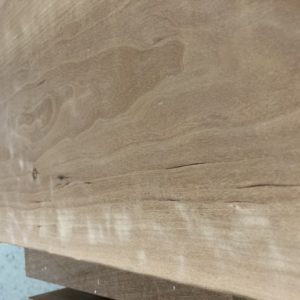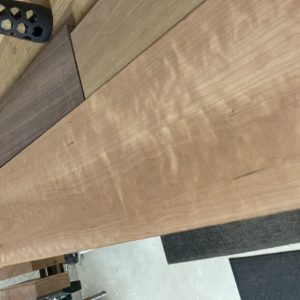Greetings
I think I have a problem maybe similar to kagoff’s recent post. https://www.finewoodworking.com/forum/sanding-and-staining-a-wood-slab
my dad had a board sitting in his garage for probably 15 years, then it sat in my brother’s basement for the past 5.
I’ve flattened it on thickness planer but there seem to be 2 issues that don’t go away no matter how many passes through the planer it goes. This board started as 5/4, now it’s a bit over 3/4 after I removed cupping.
first is the little slits you see in foreground in pic 1. Second is the discoloration that’s noticeable on left side in pic 1
i think this is cherry but that’s a guess. Please correct if you can tell it isn’t.
what to do about the slits and discoloration/splotchiness? I guess cut around the slits, but what about the splotches?
i don’t have any project in particular in mind for this. Maybe just small projects like letter trays or boxes. How would you get the most out of this board?
thanks
Neal

















Replies
If I understand you correctly, the slits are actually "spalting". Spalting is actually the beginning of rot, but don't worry. Spalting is a good thing. It adds character. Many people actively seek out spalted maple and other hardwoods.
The discoloration is figuring of the wood. Also a good thing. When the grain of the tree grows in a wavy or irregular pattern rather than a straight line, you get figuring. Cherry can be highly figured just like maple, walnut, and oak.
Lastly, yes, that looks like a nice cherry board. It will darken up over time. And once it's been sanded and finished, the figuring will have an iridescent three-dimensional quality, and it will be pleasing to the eye.
Those aren't flaws. They're the characteristics of the tree.
Pretty sure the "slits" are pockets of sap. Nice board, I would use it as is. The figure will be very pretty under a coat of finish.
Go figure, ha. It didn’t seem all that appealing to me. Maybe it’s the harsh white light in my shop combined with an inexperienced eye. Just seemed kind of (as I’ve said) splotchy. Super blond shellac is my finish of choice generally, I’m looking forward to seeing it here.
Thanks for feedback!
Neal
We call it ''mineral'' and it is a common and natural occurence in Cherry. Select grade of cherry tolerates mineral occurence, unlike other species.
Cherry. I'm working on some right now that is quite similar. Much of it I didn't discover until I resawed a 12/4 piece, but c'est la vie. I am hoping it does well with shellac. Some parts of it have been quite hard to plane -- grain constantly changing. But, yes, lots of character.
Pretty board. Lots of figure and character. Embrace it.
The difference between blotchy and curly is 4 dollars a foot.
Neil (Weymouth 2)
You mention that:
"I don’t have any project in particular in mind for this. Maybe just small projects like letter trays or boxes. How would you get the most out of this board?"
It's too late now but perhaps a lesson for the future. .... If you have a large/wide board with lots of cup in it but you intend to use smaller parts cut from that board, then it's best to cut up the board to some degree first - before planing and thicknessing the whole board. You'll need to remove less wood planing to make smaller parts flat and evenly-thick.
You mention that planning it as-is reduced it's thickness from 5/4 to near 3/4. That's half an inch of nicely figured wood now saw dust and chippings. If you'd sliced it lengthways into two narrower boards, there would be less cup per board and so less material needing to be removed to make each board flat. You would have ended up with perhaps 4/4 rather than 3/4.
The same applies to bow in a board. If you want shorter pieces to work on than the length of the board, cut those pieces to length first before removing the bow, as there will be less bow-per-plank to remove and so you end up with two thicker planks than the one thinner plank you would have got by removing bow from the full length board.
Lataxe
Lataxe, thank you, this is great advice. I think I knew this theoretically but not in practice (clearly).
I’ll chalk it up to “rookie mistake” and never make it again (one of my goals in woodworking...never make the same mistake twice).
Neal
I would add to Lataxe's advice, which is spot on as usual, don't try to cut warped or twist wood on your table saw, it simply isn't safe. A bandsaw would be my tool of choice, barring that a portable circular saw, but be on guard for binding and using wedges in the kerf can help. Depending on the degree of distortion, and your set-up, you may be able to cross-cut on a sliding miter saw but be cautious and use clamps if possible. If the distortion is too severe, or you simply aren't equipped to support longer boards properly, the portable circular saw is the way to go.
I will also add, don't beat yourself up too much over having a very nice piece of 3/4" wood to work with. The simple fact is very few projects require wood thicker than 3/4" and with only 1 board it is probably best suited for something like a small wall cabinet, maybe with glass doors to stretch the board a little further, or boxes, etc, all of which would use 3/4"wood. Also don't forget you can mix species of wood to nice effect as well.
Yes, of the various distortions that occur in timber because of the grain arrangement left in a plank, wind is the worst rascal! The twist often means that there's a significant degree of stress contained in the wood - balanced out in the twist you see in the starter plank but probably released when you cut it, to twist or warp the two parts resulting from the cut into different forms, possibly with even more twist or warp than before. Dangnabbit!
I take the point about 3/4 being the most common section in furniture .... but there are plenty of parts that might be best at anything between 1/4 and 5/4. They might be minor parts but they're needed here and there. Thicker sections can be reduced in thickness if necessary. They might even be re-sawable into two pieces (e.g. 5/4 into one 1/4 and one 3/4 section, with 1/4 available to waste into sawdust by the resawing.
But thinner parts can only be made thicker by gluing two of them face-to-face. Sometimes this looks OK (and doesn't introduce a new warp) but sometimes not.
Lataxe
I never buy a piece of wood with anything but a tiny amount of wind. So many things can go wrong, or just make life difficult. There are plenty of boards in the sea, move on.
"Plenty of boards in the sea".
Heh. At one time I had a crane driving friend who worked at a small sea dock nearby. This dock had a regular tramp steamer (well, diesel) that brought shipments of exotic timbers in planked form from various sources in Africa, for processing into expensive bits & pieces by a local first and second fitting firm. They made nice doors, staircases and so forth.
The timber was on pallets in the hold but also on the deck. The deck pallets were wedged into place using large chunks of some of the same timber planks that were on the pallets.
After the ship had unloaded and sailed, the crew heaved the plank-wedges into the sea! My crane driver mate, on hearing of this, began to rescue these wedge-planks of exotic stuff from the seamen. He gave them to me (the planks, not the seamen) for which he got some back as pieces of furniture.
There was mostly iroko, sapele, utile and one or two I couldn't identify of a similar nature to sapele. (Often grouped together as "African mahogany"). One strange timber was ekki - a hard, dense and slightly brittle dark pink timber with lots of white flecks of what was probably silica. It made very fine knockers and beetles for hitting chisels or a froe (aka a lat axe). :-)
Here are two pics of Ekki Thump.
Lataxe, only thumped by the ladywife's fist.
This forum post is now archived. Commenting has been disabled